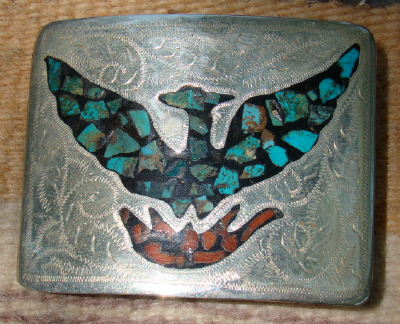Hello Paula,
I was poking around to try to identify a belt buckle which I bought based on it having been purchased on an Indian Reservation in the 1970s. It’s large and heavy and arrestingly designed so I thought I might be able to find the tribe and artist. I did find another similar buckle that had been sold and looks like it had been made by the same artist but there was no info on that one either. Would you be willing to take a look? Linda

Vintage Chip Inlay Belt Buckle
Thanks, Paula.
This is 4-1/8″ by 3″ and weighs 120 grams. Serious size. There is turquoise, coral and a brown stone about which I’m not sure. Could be tiger’s eye but I’m really not sure. All set in black, larger pieces of stone than usual and the design seems exceptional. I found this buckle by googling, which may have been done by the same person. I’d love to identify at least which peublo or tribe, if not the artist. This
is the other one I found which looks to be the same artist:

Reference Chip Inlay Buckle
Information with the above reference buckle:
Beautiful heavily vintage 50’s-60’s turquoise and coral inlay Phoenix buckle! The buckle consists of a turquoise and coral large chip inlay. The artist continues decorating with multiple etched floral designs completely around the inlay and throughout the buckle. The artist finishes by attaching a stationary solid belt holder and pin on back.The buckle measures approximately 3″ by 2 7/16″ and weighs 69.6 grams (2.45 ounces or 2.24 troy ounces). It is unsigned and possibly Mexican Alpaca Silver. It does have a yellowish haze to it meaning the other metals are more copper than nickel. The buckle will accommodate up to a 2″ wide belt.
My buckle is much more lovely in person than the pics, but enough to give you a good idea, I hope. Linda
Hi Linda,
Well you did most of the work here ! My job is easy. Before even seeing the photo and information on the reference buckle that you sent, I suspected this was a Mexican-made buckle. Although you didn’t send a photo of the back of the buckle, where one can see the effects of time on the metal, I suspect this is not sterling silver but Alpaca. If you suspect it could be sterling silver, a simple test at a jewelers will tell you whether it is or not. If it is sterling silver, due to its weight, it would be worth a lot more than if it was alpaca.
Alpaca is a term that is often stamped on Mexican (and German) pieces and sometimes it is called Alpaca Silver but it contains no silver at all. Alpaca is usually composed of 65% copper, 18% nickel and 17% zinc. It is similar to German Silver and Nickel Silver (read full article about silver here).
The stylized road runner design and the use of the large chips does not look Native American to me. Nor does the engraving which appears on both buckles. The chips seem to be made of turquoise, coral and perhaps faux tortoiseshell.
So when you say you purchased the buckle based on the fact it was purchased on an Indian Reservation in the 1970s, it sounds like it might have been misrepresented. But that is just my humble opinion !
The main thing is that if you like it, enjoy it ! Thanks for writing and best of luck.































